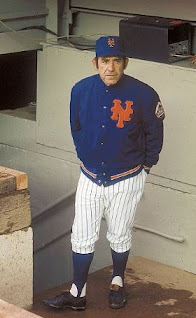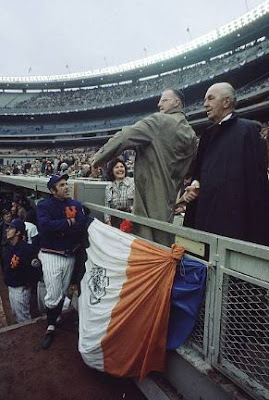Remembering Mets History (1972) On Opening Day at Shea the Mets Remember Gil Hodges & the Yogi Berra Era Begins
The 1972 season brough big changes to the Mets organization & Major League Baseball.
Players Strike: On March 31st, 1972, at the end of Spring Training the newly formed MLB Players Union headed by former steelworkers' union leader Marvin Mitchell, voted to go on strike. This was the first ever MLB Baseball strike & was the dawn of a new era to come. The season was delayed by 12 days & 86 regular season games were cancelled.
In the end there were improvements to the pension fund & arbitration was added to collective bargaining. The owners did not pay the players for the games that were missed which led to a shorter season, where teams played anywhere from six to nine less games.
Gil Hodges Death: As for the New York Mets, not only did the strike loom over Spring Training, but the organization would suffer its worst tragedy when beloved manager Gil Hodges suffered a fatal heart attack.
On April 2nd, Easter Sunday, Hodges & his coaches Joe Pignatano, Rube Walker & Eddie Yost were getting past the strike playing a round of golf. On their way back to the hotel, Gil Hodges collapsed, suffering a fatal heart attack, he fell to the ground hitting his head.
Quotes- coach Joe Pignatano: "I put my hand under Gils head, but before you knew it, the blood stopped. I knew he was dead. He died in my arms."
He was rushed to the hospital & was pronounced dead.
Gil Hodges was not only a well-respected manager that transformed the Mets from last place to World Champions, but he was also a beloved man by all that new him. His death caused a shock throughout the organization. As the season was about to start in two weeks, the lost & stunned organization needed to move on quickly.
 Yogi Berra Named Manager: They named Mets coach & New York baseball legend Yogi Berra as the team's manager. Berra was the popular choice, he had experience as he had managed the AL New York club, he was loved by everyone & had just been named to the Baseball Hall of Fame. But he probably wasn't the right choice.
Yogi Berra Named Manager: They named Mets coach & New York baseball legend Yogi Berra as the team's manager. Berra was the popular choice, he had experience as he had managed the AL New York club, he was loved by everyone & had just been named to the Baseball Hall of Fame. But he probably wasn't the right choice. The Mets Minor League VP Whitey Herzog should have gotten the job. He had had developed all the talent that came up to win the 1969 World Series & beyond. Herzog would leave the organization in frustration & go on to a Hall of Fame managerial career.
Nolan Ryan Trade: 1972 saw the Mets make one of the worst trades in history, when Nolan Ryan was sent to the California Angels in exchange for infielder Jim Fregosi.
Fregosi was a former All Star short stop brought in to play third base. At Spring Training, he arrived out of shape & struggled.
Fregosi never returned to form, by early 1973 he was gone. Nolan Ryan went on to be one of the games top pitchers setting multiple records on his way to the Hall of Fame.
Rusty Staub Trade: Another big move for the Mets that off season was a blockbuster trade where they acquired Rusty Staub from the Montreal Expos.
In exchange, the Mets sent a young Ken Singleton who would have a fine career in Montreal & Baltimore, short stop Tim Foli who had a long solid career in Montreal & Pittsburgh, as well as youngster Mike Jorgensen who also had a long career in Montreal, Texas & back with the Mets.
It must be noted that both of these deals had had Gil Hodges approval. Hodges had been after Staub for a while & was key in getting that deal done. Looking back the future was sacrificed but the Mets were looking to win right away with the good team that they had. If it's any consolation, Nolan Ryan was still suffering control issues at that point, also he & his wife Ruth were never comfortable living in New York.
The Mets had one of the leagues best pitching staff's & that year added Jon Matlack who went on to win the Rookie of the Year Award. With the added offense of Staub & Fregosi there were high expectations for the team.
In a pre-game ceremony, the Mets honored Gil Hodges & announced his number 14 would be retired. The American Flag was held at half mass & a moment of silence was observed. The team wore black arm bands on their sleeve in his honor that day & for the entire season.
The game was nationally broadcast on NBC's Game of the Week with Jim Simpson & Sandy Koufax calling the action.
The Mets hosted Bill Virdon's 1971 reigning World Series Champion Pittsburgh Pirates. Along with Berra, Virdon was the other NL's new manager. From 1970 to 1975, the Pirates were a dominating team, winning four of five NL East titles with the Mets breaking the reign in 1973.
The Mets hosted Bill Virdon's 1971 reigning World Series Champion Pittsburgh Pirates. Along with Berra, Virdon was the other NL's new manager. From 1970 to 1975, the Pirates were a dominating team, winning four of five NL East titles with the Mets breaking the reign in 1973.
In 1972, the Pirates featured a couple of Hall of Famers. Willie Stargell was the NL's reigning HR champion. Willie would also hit the most HRs of any non-Mets Player in the history of Shea Stadium.
 Roberto Clemente was in his final season before a tragic plane crash took his life. Clemente was the 1971 World Series MVP & had hit safely in 14 straight World Series games (1971 & 1960).
Roberto Clemente was in his final season before a tragic plane crash took his life. Clemente was the 1971 World Series MVP & had hit safely in 14 straight World Series games (1971 & 1960). On this Opening Day the Mets future Hall of Fame pitcher, Tom Seaver "the Franchise" would make his fifth straight Opening Day start. In 1971 Seaver had led the NL in ERA (1.76) WAR (10.2) & set a record for right handers in strike outs (289). Over the last three seasons Seaver was 7-0 against the Pirates.
Seaver went up against the eccentric Doc Ellis who was a 19-game winner in 1971. Ellis once wore curlers in his hair on the field & claims to have pitched his 1970 no-hitter while under the influence of LSD.
Tom Seaver started out the game striking out Rennie Stennett looking. After Al Oliver singled, Seaver struck out both Roberto Clemente & Willie Stargell to end the inning.
In the home 2nd inning, the newest Mets made their debuts to nice welcoming ovations from the Shea crowd.
Tom Seaver started out the game striking out Rennie Stennett looking. After Al Oliver singled, Seaver struck out both Roberto Clemente & Willie Stargell to end the inning.
In the home 2nd inning, the newest Mets made their debuts to nice welcoming ovations from the Shea crowd.
Rusty Staub led off the inning with a single, then Cleon Jones also singled. Jim Fregosi then doubled to right field scoring Staub with the Mets first run of the 1972 season. Ed Kranepool added a sac fly making it 2-0 Mets.
After a leadoff single to Stennett in the 3rd inning, Seaver retired the next seven in a row. In the 5th inning, after a base hit to Doc Ellis, Seaver got Stennett to ground into a double play. He then retired all three batters in the top of the 6th.
On the rainy afternoon, Seaver pitched six shutout innings allowing five hits while striking out six & walking nobody.
 In the bottom of the 6th inning, Jim Fregosi reached base for the second time in his debut with a two out walk. Ed Kranepool then hit a two run HR off Elli giving the Mets a 4-0 lead.
In the bottom of the 6th inning, Jim Fregosi reached base for the second time in his debut with a two out walk. Ed Kranepool then hit a two run HR off Elli giving the Mets a 4-0 lead.Tug McGraw came in for the Mets pitching three scoreless, hitless innings to earn a save. Tug McGraw was blossoming into one of the game's best relief pitchers. At that time, the relief pitcher who closed out games were not yet called closers but were known as Fireman.
The Mets won their opener 4-0. They would drop the next game to the Pirates as Steve Blass shut out Gary Gentry 2-0. The Mets would then go to Montreal as former Met Steve Renko beat them. But then from April 21st to April 28th, the team went on a seven-game win streak getting to 8-2.
The Mets would take over first place until mid-June. They finished the season 83-73 in third place. They returned in 1973 to win the NL Pennant.










